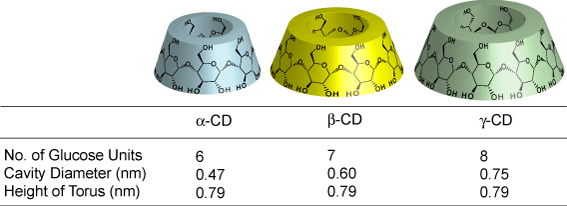About Cyclodextrin (CD)
Cyclodextrins comprise a family of three well known produced major, and several rare,minor cyclic oligosaccharides. The three major cyclodextrins are crystalline, homogeneous, nonhygroscopic substances, which are torus-like macro-rings built up from glucopyranose units. The a-cyclodextrin (a-CD) comprises six glucopyranose units, b-CD comprises seven such units, and g-CD comprises eight such units. The most important characteristics of the CDs are summarized in Table.

Fig.1 Construction of Cyclodextrin
In an aqueous solution, the slightly apolar CD cavity is occupied by water molecules which are thermodynamically unfavored, and therefore can be readily replaced by appropriate hydrophobic guest molecules. The dissolved CD as the host molecule form inclusion complexes with an appropriate hydrophobic guest molecules by the substitution of the highenthalpy water molecules.
Return to Top

